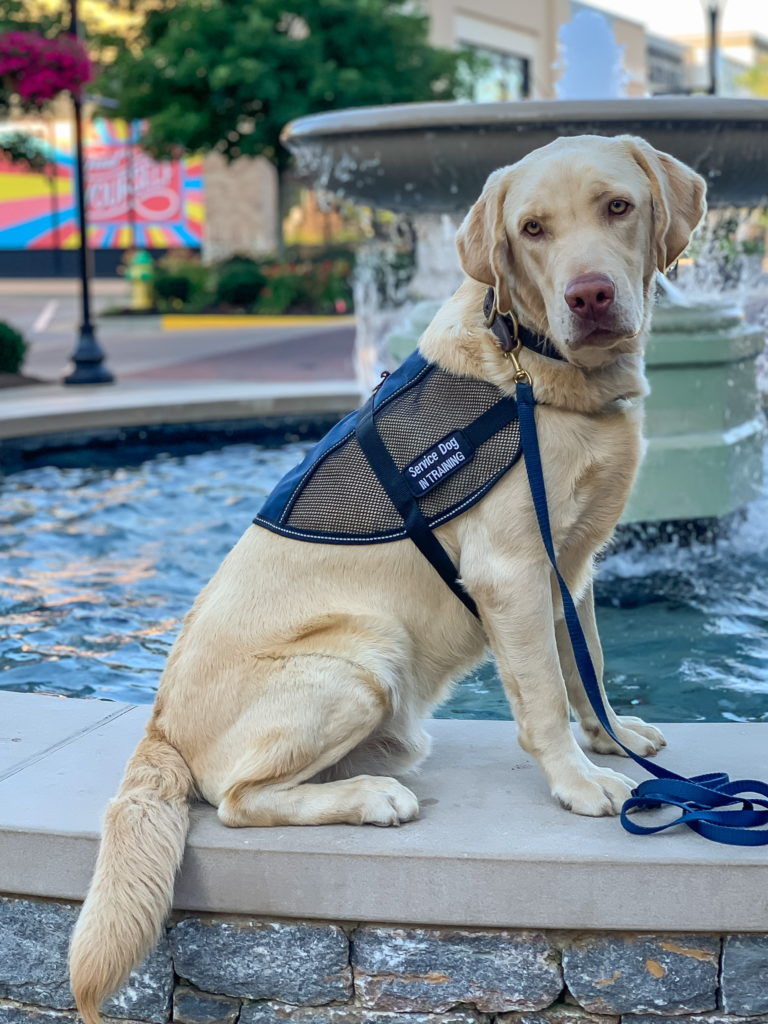
Diabetes service dogs are specially trained dogs that can make living with diabetes so much easier and safer!
With years of training for the dogs, and a lengthy education process for future owners, there’s a lot to learn about diabetes service dogs. Below, we’ll cover the basics of what they do and how someone with diabetes can go about getting an alert dog, as well as hear some real life stories about living with a diabetes alert dog.
*I want to point out before we go any further that the official term for these amazing dogs is “diabetic alert dogs.” One of the weird quirks of blogging is that we try to use phrases that people most often type into search engines. So, you’ll see me use some different terminology in this article like “diabetes service dog” or “diabetes alert dog”, because that’s what people more often search for online. But, they all are referring to diabetic alert dogs.*
What is a diabetes alert dog?
Diabetes alert dogs are very affectionately referred to as DADs. DADs offer an extra layer of protection to their owners against asymptomatic high blood sugars and low blood sugars.
To help educate myself more on this topic, I got to interview a number of different diabetes service dogs owners and a professional trainer as well. I know you’re going to enjoy learning from their experiences and expertise just like I did.
How does a service dog help a person with diabetes?
Adrienne from California has a young daughter, London, with type 1 diabetes and her diabetic alert dog, Sherlock, is a huge part of their life. Adrienne even wrote a book about their experience with Sherlock.
She relayed several stories that were quite impressive… “Having a DAD has changed our daily life in so many ways. Sherlock and London are truly best friends. In every aspect of life, Sherlock is there. He has made our life feel safer and is a constant companion for London.”
“Sherlock usually alerts me to a problem long before the dexcom. I can think of hundreds of occasions but one of the most remarkable alerts he did recently was when London was swimming. The dexcom doesn’t accurately read in the water and he alerted and she was 48. Had he not alerted I wouldn’t have tested her for another 10 minutes and who knows how low it may have been by then.”

Do diabetes alert dogs really work?
Joy from Michigan is another type 1 diabetes mom and has had a similar amazing experience with their dog Shiloh… “Shiloh has brought exactly what her name means to our home – peace. My daughter does not feel her high BGs or her low BGs. Typically she won’t feel low until she is low 50s/high40s. Often she will feel low after her BG has returned to a healthy level. She does wear a CGM but they are not foolproof and often, a DAD will catch a dropping BG before a CGM alerts.”
“With Shiloh around, we know we will catch a low before it becomes a major medical issue. She will notice [my daughter’s] dropping BG even when they are not in the same room. We feel confident going about our day without constantly checking CGM readings on our phones.”
Diabetes service dog breeds
Sometimes it blows me away how powerful social media is. I connected with Libby, founder of MD Dogs on Instagram and was so happy when she agreed to walk me through the process of how dogs can become diabetes service dogs or diabetes alert dogs.
MD Dogs offers support to both current dog owners and potential dog owners. Libby authored a collection of resources to help current dog owners train their dogs to become a DAD. She also professionally trains and places DADs in new homes.
When libby selects dogs for training she “looks for the following things: 1) Health tested parents – cleared for all breed specific health issues and excellent hips, elbows, etc. to maxize the chance that the DAD will have a long and health working life, and 2) that a dog that loves people, is food motivated, curious, confident, and eager, with quite a bit of drive so that they will want to work 24 hours a day and be thrilled to put on their vest every morning!
Libby says “The most common breeds and the ones that I recommend using are Labradors, Golden Retrievers, and poodles. I also work with field bred English Cocker Spaniels and match them with individuals who are very active and need a small dog that will keep up!”

What’s involved in diabetes service dog training?
The training given by professional trainers like Libby can take anywhere from 12-15 months.
At what age does diabetes service dog training start?
Libby: “I start most my dogs’ training the day I bring them home at 8 weeks, but I’ve also worked with adolescent and older dogs who are able to learn it just as well! I typically just don’t recommend starting after the age of 3 or 4, because it takes about 1-2 years for the dog to be reliable and most dogs retire around the age of 8-10. The older you start training the less time that they will be able to work.”
How long does the training process take?
Libby: “For the dogs I fully train, about 12-15 months. For those self training, it usually is 15-18 months before the dog is considered fully trained. However, what’s neat about self-training is the dog can start alerting to blood sugars long before then! We’ve had numerous M.D. Dogs users celebrate their puppy’s first alert within just a month or two of beginning scent training!”
“While the pups certainly won’t be reliable yet, they will already start to be able to help you monitor your BGs. The obedience and public access training to prepare them to be a full Service Dog permitted in public is what takes the longest to train. While you are still perfecting those aspects of training, your dog can be alerting you at home and already making a difference in your diabetes!”
How to get a diabetes service dog
As I mentioned above, their are kind of two ways to go about getting a diabetes alert dog:
- Train your own existing dog
- Purchase a trained dog from a qualified trainer or organization
For more information on how to train a diabetes alert dog yourself, you can read Libby’s diabetes alert dog training book.
Jessica from Florida is an adult living in Florida and recently decided to pursue getting a diabetes service dog. She shared her story with me and it is so inspiring!
“I sent a list of questions [to a DAD organization] and they were super supportive in their response and basically agreed with my husband – send your application in. I had to gather info from my primary care to verify my medical status and that I qualified for a service dog to assist. Plus reference letters from non-family members vouching for my ability to be a caring and responsible dog owner, as well as my application indicating my lifestyle and any key information they needed to make a good personality matchup with my assigned DAD. In June 2021 […] made plans to drive from Florida to Kansas for the week of training.”
“That first morning, you don’t know your dog’s name, breed, gender, etc… until they walk in the door and announce your name… But by the time he’d had dinner and breakfast in my hotel room and done let’s get ready for the day commands with me, when we walked back in for day 2 of training – we were a team!”
How much do diabetes service dogs cost?
The cost of a trained DAD varies, and can range from $8,000- $20,000 depending on a variety of factors. Some DAD owners I had the privilege of speaking with mentioned fundraising to help cover the cost, others received grants from non-profit organizations, and others paid the cost themselves.
Regardless of how the dog is paid for, they are a major investment in many ways: financially, time, emotionally, etc. But, every person I spoke with said they are absolutely 100% worth it!
Are there only type 1 diabetes service dogs? What about type 2?
The main criteria for a diabetes service dog is that the person be insulin-dependent. This more often will apply to people with type 1 diabetes, but can also apply to people with type 2 diabetes.
DADs are trained to alert you at a certain level of blood sugar. Unless you have the ability to change that blood sugar level fairly quickly, through insulin or food, it can be confusing for the dog and difficult to maintain their skill at detecting out of range blood sugars.
Diabetes therapy dog experiences
As you can tell from the experiences shared in this article, DADs can be a very beneficial tool in diabetes management. They take a big investment and continual work to maintain their training and skill, but not one person I spoke with expressed even the slightest hint of regret or like the dog wasn’t needed. These dogs are highly skilled and highly loved.





